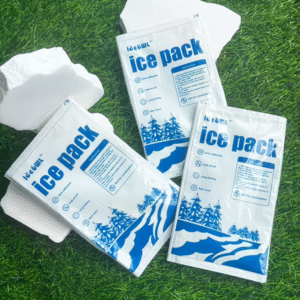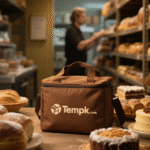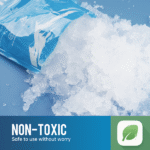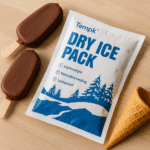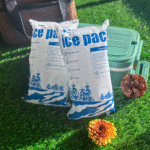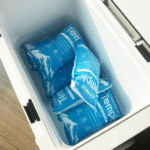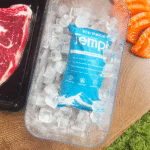Cooler Dry Ice Pack: 2025 Ultimate Guide to Safety, الاتجاهات & Cost Savings
Whether you’re shipping vaccines or sending seafood across the country, maintaining a stable temperature is critical. أ cooler dry ice pack offers ultra‑cold, moisture‑free cooling while gel packs provide reusable, moderate cold. في 2025 the stakes are higher: air freight allows only 2.5 kg of dry ice on passenger planes, and advanced gel packs now hold −12 °C to −18 °C for up to 48 ساعات. This guide helps you make informed choices, avoid hazards and optimize costs.
-
Understand what a cooler dry ice pack is and how it differs from gel‑based alternatives, including temperature ranges and safety requirements.
-
Learn safe packing, handling and storage techniques, from calculating the right amount of dry ice to venting containers properly.
-
Compare gel ice packs, مواد المتغير للمرحلة (PCMS) والجليد الجاف to identify the best solution for your products and budget.
-
Explore emerging trends in 2025, such as hybrid packages, CO₂‑capture production and smart sensors for real‑time monitoring.
-
Discover cost‑saving and compliance strategies, including reusable containers, efficient insulation and upcoming Food Safety Modernization Act deadlines.
What Is a Cooler Dry Ice Pack and How Does It Work?
A cooler dry ice pack is a cooling method that uses solid carbon dioxide (co₂) inside an insulated container to keep contents at ultra‑low temperatures. Dry ice sublimates directly into gas at −78.5 °C, leaving no liquid residue. Gel‑based “dry ice” packs are different; they contain phase‑change materials that freeze at lower temperatures and remain dry as they thaw. Understanding these differences is key to choosing the right solution for your shipment.
Understanding the Science Behind Dry Ice and Gel Packs
Dry ice is made by compressing and cooling CO₂ until it becomes a solid. على عكس الجليد العادي, it turns directly into gas (sublimation) without melting, providing consistent cold and preventing moisture damage. حزم هلام, often called “dry ice packs” but actually filled with super‑cooled gel or PCM, freeze at temperatures around −20 °C to −30 °C. New gel sheets developed in 2025 hold −12 °C to −18 °C for up to 48 hours and can be reused over 30 cycles with less than 10 % capacity loss. The key takeaway is that dry ice packs offer extreme cold for frozen goods, while gel packs provide moderate cold for refrigerated items and are more sustainable.
| محلول التبريد | Typical Temperature Range | مدة & إعادة الاستخدام | ماذا يعني لك |
|---|---|---|---|
| حزمة الثلج الجاف (CO₂ الصلبة) | فائقة (< −70 °C) | Lasts 18–24 hours per 2.5 كجم; استخدام واحد; regulated as hazardous material | Ideal for frozen vaccines, biological samples and meats; requires gloves and vented containers. |
| حزمة الجيل الجليدية / حزمة PCM | 2 °C–8 °C (تبريد) and –12 °C– –18 °C for advanced sheets | Holds cold up to 48 ساعات; reusable over 30 دورات; non‑hazardous | Best for fresh food, pharmaceuticals and meal kits; reduces waste and long‑term costs. |
| Hybrid pack (الثلج الجاف + بي سي إم) | Combines < –70 °C and 2–8 °C zones | Extends cooling duration while reducing CO₂ usage | Useful when shipping mixed products requiring both deep freeze and refrigeration. |
نصائح ونصيحة عملية
-
Know your product’s needs: Frozen goods like ice cream or biological samples require the ultra‑low temperatures of dry ice. Refrigerated goods such as fresh produce, vaccines or e‑commerce groceries fit better with gel packs or PCM.
-
Plan the transit time: Dry ice typically lasts 18–24 hours per 2.5 kg in an insulated cooler. Gel packs can maintain 2–8 °C for up to 48 ساعات.
-
Check regulations: Dry ice shipments are classified as hazardous and must be labeled “UN 1845” with the net weight specified. Gel packs usually avoid hazardous labelingshipmercury.com.
-
Consider safety gear: Always handle dry ice with cryogenic gloves and goggles to prevent frostbitetempcontrolpack.com. Gel packs require no special equipment.
How to Use a Cooler Dry Ice Pack Safely for Shipping and Storage
Proper packing and storage ensure that your cooler dry ice pack performs optimally without endangering handlers or products. Dry ice is considered a hazardous material; compliance and planning are paramount.
Packaging Best Practices
-
Use insulated containers: Choose thick foam or vacuum insulated panels (كبار الشخصيات) to slow sublimation and maintain temperaturetempcontrolpack.com. VIPs are up to five times more efficient than polystyrene panelsshipmercury.com.
-
تنفيس الحاوية: Ensure the cooler has ventilation holes to allow CO₂ gas to escapetempcontrolpack.com. Sealing a dry ice container can cause pressure build‑up and explosions.
-
Calculate the right amount of dry ice: As a rule of thumb, use about 2.5 kg of dry ice per 24 hours of shippingtempcontrolpack.com. For longer transit times, multiply accordingly.
-
Cushion your items: Secure products with bubble wrap or padded inserts to prevent damage during transittempcontrolpack.com.
-
Label properly: Mark packages with “Dry Ice” and the UN 1845 number, and declare the net weighttempcontrolpack.com.
-
Avoid sealed storage: Never store dry ice in airtight containers or refrigerators. Use a ventilated cooler and keep it in an outdoor shed or garagetempcontrolpack.com.
Calculating Dry Ice Requirements and Handling Precautions
-
Estimate weight: Determine how long your shipment will be in transit and multiply the hours by roughly 0.1 kg per hour of dry ice. مثال: a 48‑hour shipment requires about 5 كجم من الجليد الجاف.
-
Transfer leftover dry ice: After unpacking a shipment, salvage any remaining dry ice using tongs and place it in a vented coolertempcontrolpack.com. Store the cooler in a ventilated area away from heat sourcestempcontrolpack.com.
-
Plan quick reuse: Dry ice sublimates at around 5–10 pounds per day; use any leftover within two to three daystempcontrolpack.com.
-
ارتداء معدات الحماية: Use insulated gloves and goggles when handling dry icetempcontrolpack.com, as direct contact can cause severe frostbite.
-
Keep dry ice separate: Do not store dry ice with other chemicals or in sealed areas; separate it from flammable materialstempcontrolpack.com.
| Packaging Element | Purpose | مصلحتك |
|---|---|---|
| Insulated cooler/VIP panels | Reduce thermal loss and slow sublimationshipmercury.com | Keeps goods cold longer and reduces dry ice consumption, توفير المال |
| Vent holes or loose lid | Allow CO₂ gas to escapetempcontrolpack.com | Prevents pressure buildup and potential explosions |
| Clear labeling (و 1845) | Complies with IATA and DOT regulationstempcontrolpack.com | Avoids fines and ensures carriers handle the package correctly |
| Padded inserts and void fill | Protects fragile items and maintains temperaturetempcontrolpack.com | Reduces risk of damage and temperature fluctuations |
Safe Storage Tips
-
Store in insulated, حاويات تهوية: Transfer leftover dry ice into a foam or thick plastic cooler with a loosely fitting lidtempcontrolpack.com.
-
Location matters: Keep the cooler in a garage or outdoor shed to prevent CO₂ accumulation indoorstempcontrolpack.com.
-
مراقبة التسامي: Check the remaining dry ice each day. Use within a few days to maximize coolingtempcontrolpack.com.
-
Donate unused dry ice: If you have excess dry ice you won’t use, consider donating it to a local lab or restauranttempcontrolpack.com.
-
Don’t refreeze dry ice: Once it has sublimated fully, you cannot reconstitute it. Save only solid piecestempcontrolpack.com.
How to Prepare Gel Ice Pack Sheets
New dry ice pack sheets introduced in 2025 require preparation. To maximize performance:
-
Hydrate the sheet: Submerge the sheet in cold water for 3–5 minutes to allow the cells to absorb watertempcontrolpack.com.
-
تجميد شقة: Lay the hydrated sheets flat in a freezer at ≤–25 °C and freeze for at least 10 ساعاتtempcontrolpack.com.
-
Pre‑chill your shipper: Cool your shipping container before loading to extend cooling timetempcontrolpack.com.
-
Pack strategically: Wrap fragile items and position the sheets around the product for maximum coveragetempcontrolpack.com.
-
Add monitoring: Include an NFC or Bluetooth temperature logger to track conditions in real timetempcontrolpack.com.
By following these steps, you ensure that both dry ice and gel pack solutions deliver consistent performance without compromising safety.
Comparing Gel‑Based Dry Ice Packs and Traditional Dry Ice: Pros and Cons in 2025
Choosing between gel ice packs and dry ice depends on temperature requirements, مدة الشحن, safety and cost. Gel packs are gaining popularity due to their reusability and lower environmental impacttempcontrolpack.com, while dry ice remains indispensable for deep‑frozen goodstempcontrolpack.com.
Advantages and Disadvantages of Gel vs Dry Ice Solutions
Advantages of Gel Ice Packs
-
Safer handling: Gel packs are non‑toxic and require no special safety equipment, reducing the risk of frostbitetempcontrolpack.com.
-
Eco‑friendly and reusable: Many gel packs are biodegradable and can be refrozen dozens of times, cutting waste and hazardous materials feestempcontrolpack.com.
-
Cost‑effective over time: Reusability can lower packaging costs by up to 75 % compared to single‑use dry icetempcontrolpack.com.
-
التنوع: Gel packs suit food, pharmaceutical and e‑commerce shipmentstempcontrolpack.com.
Disadvantages of Gel Ice Packs
-
نطاق درجة حرارة محدودة: They cannot reach the extreme temperatures needed for frozen goodstempcontrolpack.com.
-
مدة أقصر: Gel packs may thaw faster in hot climates or long transitstempcontrolpack.com.
مزايا الجليد الجاف
-
Ultra‑low temperatures: Dry ice provides sub –70 °C conditions, ideal for biological samples and frozen foodstempcontrolpack.com.
-
Long‑lasting: With proper insulation, dry ice can maintain low temperatures for extended periods, في بعض الأحيان يصل إلى 72 ساعاتtempcontrolpack.com.
Disadvantages of Dry Ice
-
Handling risks: Without gloves and ventilation, dry ice can cause frostbite and CO₂ builduptempcontrolpack.com.
-
One‑time use and high cost: Dry ice must be replenished for each shipment and incurs hazardous materials feestempcontrolpack.com.
-
Environmental impact: Sublimation releases CO₂ into the atmospheretempcontrolpack.com.
| ميزة | حزم الجليد هلام | الجليد الجاف | ماذا يعني لك |
|---|---|---|---|
| نطاق درجة الحرارة | –20 °C to –30 °C (advanced PCM sheets hold –12 °C to –18 °C)tempcontrolpack.com | < –70 °Ctempcontrolpack.com | Choose gel for refrigeration; dry ice for deep‑freeze. |
| Handling safety | No special precautions; غير سامةtempcontrolpack.com | يتطلب القفازات, goggles and ventilationtempcontrolpack.com | Gel packs are safer for staff and end‑users. |
| Environmental impact | Biodegradable and reusabletempcontrolpack.com | CO₂ emissions upon sublimationtempcontrolpack.com | Gel packs align with sustainability goals. |
| يكلف | Lower long‑term cost; reduce packaging expenses by up to 75 %tempcontrolpack.com | High recurring cost; single‑usetempcontrolpack.com | Gel packs save money over multiple shipments. |
| Regulatory requirements | Generally non‑hazardousshipmercury.com | Must display UN 1845, hazard class and weighttempcontrolpack.com | Gel packs simplify compliance. |
Practical Scenarios and Solutions
-
Shipping fresh seafood (moderate cold): Choose gel ice packs or PCM containers. They keep seafood at 2–8 °C without freezing, الحفاظ على الملمس والنكهة. Use insulated containers and avoid overpacking to reduce weight.
-
Transporting vaccines (مبردة): Use PCM packs engineered to maintain 2–8 °Cshipmercury.com. They provide stable temperatures and simplify regulatory compliance compared with dry ice.
-
Sending frozen food (deep freeze): Dry ice is necessary for maintaining –20 °C or lower. Pair dry ice with VIP insulation to extend duration and reduce the amount neededshipmercury.com.
-
Mixed shipments (freeze and chill): Consider hybrid solutions combining dry ice and PCM. This strategy reduces CO₂ usage while keeping different zones at the required temperaturestempcontrolpack.com.
حالة العالم الحقيقي: A biotech firm switched from gel packs to PCM containers for 2–8 °C payloads and achieved a 40 % cost reduction after 10 الشحناتshipmercury.com. Another gene therapy company used validated dry‑ice shippers for ultra‑cold materials and cleared customs without HAZMAT issuesshipmercury.com.
Innovative Trends and Future Developments for Cooler Dry Ice Packs in 2025
Cold chain logistics is evolving quickly. Several innovations are reshaping how cooler dry ice packs and alternatives are made, used and tracked.
Sustainable Dry Ice Production and CO₂ Capture
Many suppliers now capture CO₂ from industrial processes like ammonia synthesis to produce dry icetempcontrolpack.com. This reduces the product’s carbon footprint and supports circular carbon use. As sustainability regulations tighten, demand for low‑emission dry ice is expected to grow.
Hybrid and Smart Packaging Solutions
Hybrid packaging combines dry ice and PCMs. These pack‑outs use a small amount of dry ice with reusable PCM panels to extend cooling duration and minimize CO₂ consumptiontempcontrolpack.com. Smart packaging integrates temperature sensors and QR codes that provide real‑time monitoringtempcontrolpack.com. Devices like Artyc’s Medstow 5 L cooler use battery‑powered compressor cooling and onboard sensors to eliminate dry ice altogetherblog.gettransport.com. Paired with telematics platforms like Catena, these trackers deliver live data on temperature, location and shocksblog.gettransport.com.
Eco‑Friendly Gel Ice Packs and PCMs
Gel packs now incorporate biodegradable materials and phase‑change substances that are safer for the environmenttempcontrolpack.com. Manufacturers are developing recyclable packaging for dry ice as well. Market projections suggest that the cold‑chain logistics market is growing by roughly 10 % سنويا, driven by demand for sustainable solutionstempcontrolpack.com.
Battery‑Powered Alternatives to Dry Ice
New battery‑powered refrigeration devices are gaining traction. على سبيل المثال, the Medstow 5 L cooler replaces dry ice with programmable temperature settings, on‑board sensors and GPSblog.gettransport.com. Founders argue that dry ice is becoming “cumbersome” and that real‑time visibility improves reliabilityblog.gettransport.com. Although initial costs are higher, these devices promise lower operating expenses, zero hazardous materials, and constant temperature control.
Market Insights and Growth Trends
According to industry reports, the temperature‑controlled packaging market is expected to rise from US$ 11.3 مليار في 2020 to US$ 16.8 مليار من قبل 2025shipmercury.com. The gel ice pack market is also expanding, with advanced products offering longer cooling durations and better reusability. Disposable gel packs and PCMs are gradually replacing traditional ice across the meal‑kit and pharmaceutical sectors.
Optimising Costs and Compliance in Cold Chain Logistics: Strategies for 2025
Reducing expenses and meeting regulations are top priorities for shippers. Here are key strategies drawn from industry experts.
Select Efficient Packaging Materials
-
Vacuum insulated panels (كبار الشخصيات): VIPs can be up to five times more efficient than traditional polystyrene or polyurethane panelsshipmercury.com. Although they cost more initially, they reduce container size and improve temperature stability, resulting in long‑term savings.
-
Reduce empty space: Minimize voids inside packages to lower dimensional weight costs and maintain temperature stabilityshipmercury.com.
-
Hybrid materials: Combine VIP with polyurethane panels to increase efficiency by 2.5×shipmercury.com.
Adopt Smart Monitoring Devices
IoT sensors offer real‑time data on temperature, الرطوبة والموقعshipmercury.com. With the Food Safety Modernization Act’s compliance deadline approaching in يناير 2026shipmercury.com, adopting these tools is no longer optional. Cloud‑based analytics help detect trends and prevent equipment failuresshipmercury.com.
Switch to Reusable Containers and PCMs
Reusable containers like Credo™ cubes reduce waste and deliver 3–4× cost efficiency compared with single‑use shippersshipmercury.com. PCMs offer stable, reusable temperature control without hazardous materials restrictionsshipmercury.com.
Plan Maintenance and Lifecycle Management
Regularly inspect and maintain coolers, sensors and packaging to avoid breakdowns and product spoilageshipmercury.com. Rotate gel pack inventories to ensure each pack goes through full freeze–thaw cyclestempcontrolpack.com.
Leverage Data for Logistics Optimization
Use analytics from sensors to optimize routes, reduce fuel consumption and anticipate delaysshipmercury.com. Integrated tracking platforms (على سبيل المثال, Surfact’s “Emma” sensor with Catena telematics) close data gaps across the supply chainblog.gettransport.com.
By combining efficient materials, smart monitoring and maintenance, you can reduce shipping costs while keeping products safe and compliant.
2025 الاتجاهات & Market Insights for Cooler Dry Ice Pack Solutions
The cold‑chain industry in 2025 is characterized by rapid growth, innovation and sustainability efforts.
-
Growth in temperature‑controlled packaging: Market size is projected to reach US$ 16.8 مليار من قبل 2025, up from US$ 11.3 مليار في 2020shipmercury.com. This growth is driven by e‑commerce, meal‑kit services and biologics.
-
Reusable and hybrid solutions: Reusable gel packs and hybrid packages are reducing waste and hazardous materials feestempcontrolpack.com. PCMs are gaining traction due to superior thermal stability and ease of complianceshipmercury.com.
-
Smart monitoring adoption: The rise of real‑time sensors and telematics partnerships shows that visibility is becoming a standard expectationblog.gettransport.com.
-
Regulatory focus: The Food Safety Modernization Act’s upcoming enforcement means shippers must adopt validated packaging and data‑logger systemsshipmercury.com.
-
الاستدامة: CO₂‑capture dry ice production and biodegradable gel packs reflect a broader shift toward circular economy practicestempcontrolpack.com.
These trends underscore the importance of selecting solutions that balance performance, cost and environmental impact.
الأسئلة المتداولة
س 1: Are cooler dry ice packs safe for air travel? – Yes, but there are strict regulations. Packages must be labeled with “UN 1845,” the dry ice weight and a Class 9 تسمية الخطرtempcontrolpack.com. Passenger flights limit each package to 2.5 كجم من الجليد الجاف; cargo flights allow up to 200 كجمtempcontrolpack.com. Always use vented containers and gloves during packing.
Q2: How long does a cooler dry ice pack last? – A typical dry ice pack provides cooling for 18–24 hours per 2.5 kg in a well‑insulated coolertempcontrolpack.com. Gel packs can maintain a 2–8 °C temperature for up to 48 ساعاتtempcontrolpack.com. Duration varies based on insulation and ambient temperature.
س 3: Can I reuse dry ice packs? – You can reuse dry ice only if solid CO₂ remains after the first shipmenttempcontrolpack.com. Transfer leftover dry ice into a ventilated cooler and use it within two to three daystempcontrolpack.com. Gel packs and PCM packs are fully reusable and can last over 30 cycles with minimal capacity losstempcontrolpack.com.
س 4: What’s the difference between a cooler dry ice pack and a gel ice pack? – A cooler dry ice pack uses solid CO₂ to provide ultra‑cold temperatures (–78.5 °C) and is classified as hazardoustempcontrolpack.com. Gel ice packs contain a refrigerant gel or PCM that freezes at –20 °C to –30 °C and can be reusedtempcontrolpack.com. Gel packs are safer to handle and better for moderate temperatures.
س 5: How can I reduce shipping costs for cold chain goods? – Opt for efficient insulation like VIPs, reduce empty space, switch to reusable containers and adopt smart monitoring devicesshipmercury.com. Combining PCM packs with small amounts of dry ice in hybrid packaging can lower both cost and environmental impacttempcontrolpack.com.
ملخص وتوصيات
Maintaining product integrity in the cold chain requires understanding your cooling options. Cooler dry ice packs deliver ultra‑cold temperatures but come with safety and regulatory requirementstempcontrolpack.com. حزم الجليد هلام و PCM solutions provide moderate cold, are reusable and reduce wastetempcontrolpack.com. Hybrid packaging and smart sensors are emerging as the future, combining efficiency with sustainabilitytempcontrolpack.com. To optimize your operations:
-
Assess your temperature range: Use dry ice for frozen goods and gel/PCM packs for refrigerated goods.
-
Invest in high‑efficiency insulation: VIP panels reduce dry ice consumption and lower shipping costsshipmercury.com.
-
Adopt smart monitoring: Implement IoT sensors to track temperature, humidity and location in real timeshipmercury.com.
-
Plan for regulatory compliance: Label dry ice shipments correctly, train staff and consider non‑hazardous alternatives when possibletempcontrolpack.com.
-
Explore hybrid and battery‑powered solutions: Combine dry ice and PCMs or invest in battery‑powered coolers for longer journeysblog.gettransport.com.
By taking these steps you’ll protect your products, meet regulations and save money.
حول Tempk
Tempk is a leading provider of cold chain packaging solutions, offering high‑quality cooler dry ice packs, عبوات جل الثلج, PCM containers and insulated shipping products. Our mission is to help businesses deliver temperature‑sensitive goods safely and efficiently. We invest in sustainable materials and smart technology, and our products comply with international safety standards. With decades of cold chain expertise, we’re here to support your logistical needs, whether you ship pharmaceuticals, food or industrial goods.
Ready to optimize your cold chain? Contact us to learn more about selecting the right cooler dry ice pack, integrating smart sensors or designing a hybrid packaging solution tailored to your shipment.






